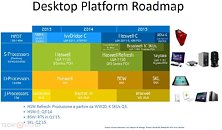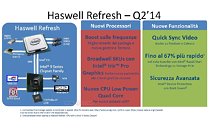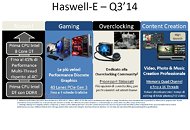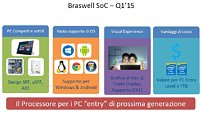Tuesday, June 10th 2014

Intel Desktop CPU Roadmap Updated
Intel's presentation for Italian technology conference 3D Revolution 2014 was leaked to the web, revealing the company's most up-to-date desktop CPU roadmap, which looks deep into 2015. It reveals a wealth of new information. To begin with the HEDT (high-end desktop) segment, Intel plans to drag Core i7 "Ivy Bridge-E" through Q3-2014, and launch its succeeding Core i7 "Haswell-E" processor close to Q4-2014, or late into Q3, which would pin its launch some time in September 2014. "Haswell-E" is built in the new socket LGA2011-3 package, and is supported exclusively by Intel X99 Express chipset. It also heralds DDR4 memory to the consumer space. "Haswell-E" will have its reign till late-Q3 2015, when Intel plans to launch Core i7 "Broadwell-E," which is built in the same package, and supported by the same X99 platform, but based on a swanky new 14 nm silicon.
Things get interesting with the company's mainline desktop processors. Intel recently launched its "Haswell" Refresh silicon, and is bound to launch their unlocked variants, codenamed "Devil's Canyon," on the 25th of June. Built in the LGA1150 package, "Haswell" Refresh runs on both 8-series and 9-series chipset. Intel's 9-series chipset was originally designed to launch alongside the company's first processors built on the 14 nm silicon fab process, codenamed "Broadwell," which is an optical shrink of "Haswell," with a few minor tweaks and speed bumps, just as "Ivy Bridge" was to "Sandy Bridge." Intel's "Broadwell" chips are now expected to debut in Q1-2015, probably along the sidelines of the 2015 International CES. These chips will be supported by existing LGA1150 motherboards, some with BIOS updates.In mid-2015, probably around the same time as Computex 2015, Intel plans to debut its next-generation Core "Skylake" processors. Notice that "Skylake" launches less than six months apart from "Broadwell." It looks like Intel will launch unlocked "K" series parts of "Broadwell" in Q1, but reserve unlocked "K" series "Skylake" chips for 2016, so overclockers are stuck with "Broadwell." It's also important to note that just as every new micro-architecture heralds a new CPU socket, "Skylake" will bring with it the new LGA1151 socket, which is incompatible with LGA1150.
Moving further down to the U-segment (ultra-low power desktop), in which chips that don't exceed 25W TDP are positioned, Intel plans to launch "Broadwell" based BGA chips in a couple of months from now, followed by "Skylake" based BGA chips in mid-2015. The entry-level J-segment processors sees the scrapping of the Atom brand, with Celeron and Pentium "BayTrail-D" extending till late-December, and "Braswell-D" taking charge of the lineup in early-2015.
Things get interesting with the company's mainline desktop processors. Intel recently launched its "Haswell" Refresh silicon, and is bound to launch their unlocked variants, codenamed "Devil's Canyon," on the 25th of June. Built in the LGA1150 package, "Haswell" Refresh runs on both 8-series and 9-series chipset. Intel's 9-series chipset was originally designed to launch alongside the company's first processors built on the 14 nm silicon fab process, codenamed "Broadwell," which is an optical shrink of "Haswell," with a few minor tweaks and speed bumps, just as "Ivy Bridge" was to "Sandy Bridge." Intel's "Broadwell" chips are now expected to debut in Q1-2015, probably along the sidelines of the 2015 International CES. These chips will be supported by existing LGA1150 motherboards, some with BIOS updates.In mid-2015, probably around the same time as Computex 2015, Intel plans to debut its next-generation Core "Skylake" processors. Notice that "Skylake" launches less than six months apart from "Broadwell." It looks like Intel will launch unlocked "K" series parts of "Broadwell" in Q1, but reserve unlocked "K" series "Skylake" chips for 2016, so overclockers are stuck with "Broadwell." It's also important to note that just as every new micro-architecture heralds a new CPU socket, "Skylake" will bring with it the new LGA1151 socket, which is incompatible with LGA1150.
Moving further down to the U-segment (ultra-low power desktop), in which chips that don't exceed 25W TDP are positioned, Intel plans to launch "Broadwell" based BGA chips in a couple of months from now, followed by "Skylake" based BGA chips in mid-2015. The entry-level J-segment processors sees the scrapping of the Atom brand, with Celeron and Pentium "BayTrail-D" extending till late-December, and "Braswell-D" taking charge of the lineup in early-2015.




34 Comments on Intel Desktop CPU Roadmap Updated
Broadwell better have some increases otherwise its not worth buying with locked/unlocked Skylakes around the corner.
Innteresting, I haven't heard anywhere else that the Skylake K are being pushed into 2016.
I recall years ago the uproar in the enthusiast circles when the rumor was that Broadwell would be BGA only. It looks to me these old rumors are mostly true, and the only thing new is that Intel caved to making a socketed Broadwell K part for enthusiasts only.
It looks like anyone who wants to build an Intel system on a budget in the first half of 2015 will either have to go with a socketed Haswell refresh chip or a BGA Broadwell.
I'm good with this until then:
I was already planning for Haswell-E since I need an upgrade and Broadwell-E will probably be just as disappointing as Ivy Bridge-E because it's only a die shrink. If I could wait I would wait for Skylake-E which seems to release towards the end of 2016.
According to the fine print... I see 3.4ghz for HW-E 8c and 3.5Ghz for HW 4c ... 45% better for double the cores and 100mhz less.If broadwell gets ddr4 support that means new motherboards yet again... and it is supposedly using the same chipset. I don't think the plebeian socket gets ddr4 till skylake.
www.youtube.com/watch?feature=player_detailpage&v=KeDtXucTwRI#t=19
Kirk Skaugen, senior vice president and general manager of the PC Client Group at Intel, said; Broadwell is going to enable two different types of devices, One you can plug the chips directly into existing systems and second we will have brand new systems and with a broad new range of fanless designs.
This was with Z87 in mind and second Z97, since there was no announcement Z97 yet back then. I bet Z87 will get another IMEI & micro code update and should be BD ready too. :)
Intel added these 3 new feature setsPrefecthw looks interesting,
PREFETCHW – Prefetch at least a 32-byte line into L1 data cache (this is the non-deprecated instruction), for SIMID, SSE, AVX
By "existing systems" he means "existing form factors and/or chassis designs" rather than old computers. The comment means that OEMs can easily go to the factory and change which chips (either Haswell or Broadwell) are soldered to the motherboards of new laptops while saving money by being able to continue using existing motherboard designs and laptop chassis designs. This interpretation also makes sense when considering the second type of device, the "brand new systems" with "fanless designs", which refers to laptops with new motherboard and chassis designs targeted specifically for Broadwell.
The video unfortunately makes no reference to desktop Broadwell and which (if any) Broadwell chips will be socketed. If the roadmap is to be believed, there will only be a few socketed Broadwell models and prices will start at ~$250 (the lowest price K chip).